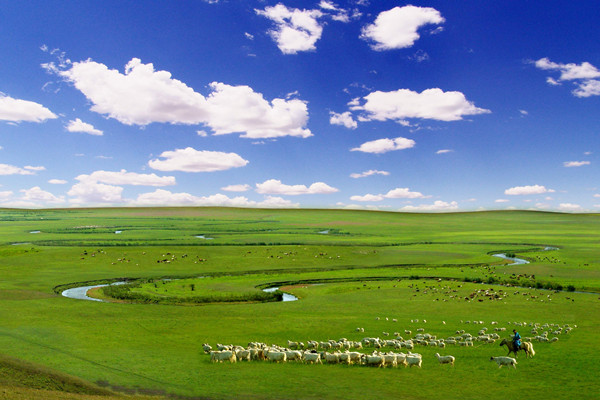Animal husbandry
 |
The grasslands cover about 86.67 million hectares - including 68 million hectares of agricultural grasslands - accounting for one quarter of the country's total. |
Inner Mongolia, with its vast grasslands, is one of China's major bases for husbandry products.
The grasslands cover about 86.67 million hectares - including 68 million hectares of agricultural grasslands - accounting for one quarter of the country's total.
More than 1,000 kinds of forage plants - including about 100 kinds with high feeding value and palatability, such as leymus chinensis, fescue wheatgrass and wild oat - grow in the prairie of the autonomous region, including in Hulunbuir, Xilin Gol, Horqin, Ulanqab, Ordos and Wulate.
The meadow grasslands in northeast Inner Mongolia boast fertile soil, abundant rainfall, and a variety of forage, which provide an ideal environment for livestock breeding, especially cattle. The high nutrition forage on the arid grassland of central and southern Inner Mongolia is good for horses, cattle and sheep, though the species, density and output of forage there are not more than the meadow grassland in northeast..
The desert steppe in the north of Yinshan Mountains and west Erdos Plateau is suitable for breeding small livestock, due to the fat and protein in its forage, in spite of the dry climate and poor species of forage. The desert grassland in the western part of Inner Mongolia is good for raising camels.
Inner Mongolia is known for various livestock, including the Sanhe Hippos, Sanhe Cattle, Red Bulls, Erdos fine-wool sheep and the Arbas Cashmere Goat.
In 2020, Inner Mongolia's total meat production for pig, cattle, sheep and poultry came in at 2.60 million metric tons, up 1.5 percent from the previous year.
Of that, pork output was 614,000 tons, a year-on-year decrease of 1.9 percent; beef output was 663,000 tons, up 3.9 percent; lamb output was 1.13 million tons, up 2.9 percent; poultry meat output was 201,000 tons, down 3 percent; and the output of poultry eggs was 604,000 tons, a 4-percent rise compared with the previous year.
Meanwhile, annual milk output throughout the autonomous region was 6.12 million tons, an increase of 5.9 percent.
Livestock in Inner Mongolia totaled 71.79 million heads in 2020, up 3.5 percent from the previous year. Of that, there were 5.34 million live pigs, an increase of 24.3 percent; 6.71 million heads of cattle, up 7.2 percent; and the numbers of sheep and poultry were 60.74 million and 53.47 million, increasing 1.6 percent and 2.9 percent, respectively.



 Print
Print Mail
Mail





